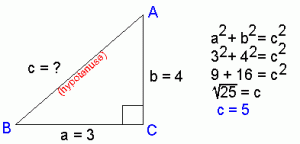Blog #32
“Angles in a triangle”
A rule we learned about today in Math is that all of the angles of a triangle add up to 180°. If this does not happen, the shape you will get will not be a triangle. An example of this would be having a triangle with the angles 90°, 30°, and 60°. These all add up to 180° and therefore make a triangle. This is useful for finding out missing angles since if you know the other two, you can easily find out what angle added to the other values will add up to 180°.
Blog #33
“Triangle inequalities”
There are several aspects that determine if a shape will be a triangle. Surprisingly, one of the ways to tell is by looking at the association between the smaller sides and the bigger side. There is in fact a relationship between the sides of a triangle. The rule is, unless the 2 smaller sides are equal or smaller to the the other bigger side, it will not be able to count as a triangle. This is simply because they won’t be able to connect to make a geometric shape.
Blog #34
“Triangle side length pattern”
There are patterns between the areas of the two smaller squares and the area of the larger square that form the triangle. One of the patterns are if the three squares have sides that makes an acute triangle, then the sum of the areas of the two small squares will be bigger than the larger area. If the three squares have sides that make an obtuse triangle, then the sum of the small square area will be smaller than the larger area. And if the three sides that make a right triangle, then the sum of the two small square areas will have to be equal to the larger area.
Blog #35
“Square roots”
Square root is how many times do you need to multiply a number by itself to get the area. To estimate square root first, solve for the number by multiplying it 2 times it self. If it has a decimal you need to decide wether is lower than . 4 or higher than .5. If it is lower than .4 you leave it as it is but if its higher than .5 you need to round it. Perfect squares have a square root as a whole number. Non-perfect squares have decimals in the number that us when you decide wether to round it or not.
Blog #36
“Pythagorean theorem”
You can find one angle of a triangle by using the pythagorean theorem. You have the legs and the hypotenuse. In order to find the hypotenuse you need to use the area from the legs. If you need to find a leg you subtract the area of the hypotenuse from the area of the leg.







Leave a Reply